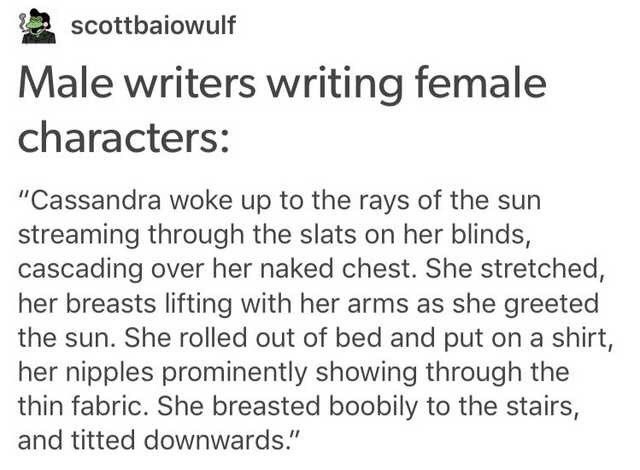
Welcome to my series on worldbuilder’s disease: a Sci-Fi/Fantasy problem in which aspiring writers end up with notebooks full of history/backstory, but no drafted words on the page. This is the third post in the series – click to check out the first and second posts.
Last week, I wrote about draft-blocked and plot-blocked processes and how to overcome them to get a draft out. This week, we’ll look at strategies for overcoming revision-related blocks. While revision-blocked writing isn’t unique to the SFF landscape, it can certainly come as a result of worldbuilder’s disease, so I’ve included it in this series.
Revision-blocked writers come in two different flavors:
- The structure-blocked writer, and
- The perfection-blocked writer.
Structure-blocked writers
Structure-blocked writers start their projects with boundless enthusiasm, churn through the first several chapters of their manuscript, then abruptly lose interest (or: find it impossible to continue).
A close cousin of the plot-blocked writer, many structure-blocked writers don’t know where to go with their story after the opening chapters – or find everything between the opening and the ending too boring to write.
SB writers tend to either 1) abandon their project in favor of a shiny new WIP (work-in-progress), or return to the beginning and fuss, fuss, fuss with their initial chapters.
I like to think of SB writers as folks who have a partially-assembled piece of Ikea furniture sitting in the corner of their living room. A bag of all the spare bits and pieces they couldn’t figure out how to fit into the furniture – let’s call it a bookshelf – sit in a bag on top.
How do we go from a structural disaster to an immaculate Kallax unit?
By reading the directions. Or, to zoom out of this weird furniture metaphor and apply it to our writing: by having a roadmap.
Structure-blocked writers often start writing with an idea for the beginning, an end, and an empty wasteland of a middle. This is a plot-structure problem. In order to fix it, we need a roadmap.
You may say, “But Cee, I hate plotting!”
That’s fine! Remember, plotterßàpantser is a wide spectrum. Plotting work =/= scene level outlines if you don’t want it to.
If you’re a structure-blocked writer who needs to find a workable way to build a scaffold for the sagging middle of your novel, here are two different techniques to try. Each involves a different level of pre-plotting intensity to help you get past the black hole that opens up the moment you draft chapter four.
- Low-intensity plotting: flashlight/waypost method
If plotting sucks the life out of you, try the flashlight/waypost method (aka Plotting Lite).
The flashlight method = working towards the end.
Working towards the end means taking a look at the current drafted chapters and asking ‘ok, given what I’ve already got on the page, what interesting thing can I make happen next?’
Or, as some authors put it, “how can I leave the most blood on the floor?”
When you’re stuck and all of the options you come up with seem boring, that’s when you want to wreck your character’s life. Throw them an unhittable curve ball. Burn down their house. (Sometimes literally.)
‘Boring’ comes from a dearth of compelling conflict – so create some. Think of an event (a breakup, a death, a horrible loss) that will propel the character forward and give them something to fight for/against/toward.
It may yet be unclear how that conflict will fit into the greater narrative, but hey, that’s why flashlight-method writers are often called “discovery” writers.
You’ll think of something.
And even if it winds up being the wrong turn, or a scene you need to tweak for it to sit right – it got you writing, didn’t it? You can fix wrong turns. You can’t fix a blank page.
The waypost method = working towards the middle.
Working towards the middle is the same concept, but turned on its head. Instead of putting blood on the floor right away, you try to find the mid-point between the last chapter you have drafted and the next major event set in stone in your book.
This might very well be the climax/ending. If that’s the case, you want to focus on the midpoint.
(Side-note: I absolutely swear by the midpoint as one of the most, if not *the* most, important parts of a book. If you dread the middle, try to think of it as an opportunity instead of a chore.)
What huge event happens halfway through your novel? The midpoint clarifies and raises the stakes, changes the game for the protagonist, and adds a plot twist to show the protagonist the true nature of the enemy they’re facing.
What kind of event would do that?
Once you have that event, cut the story in half again – go between the last chapter you wrote and the midpoint. What has to happen halfway between those two points to get the characters to the Midpoint Event?
Then cut it in half again, and again, and again – until you have a roadmap of how to get yourself to the halfway mark. These are your major plot points. Instead of writing into a sagging, soggy void, you can write your way from waypost to waypost, adding more as necessary whenever you come upon a big blank chunk of time.
To summarize:
Pros: flashlight/waypost will get you writing! It’s better for pantsers and plantsers who find the will to write sucked out of them when adhering to a strict plotting structure. Best for those who enjoy the editing and revisions process, because…
Cons: The end result could need a lot of revision.
Caveats: It’s still possible to get stuck! In that case, it’s safe to assume the story has taken a wrong turn somewhere. This could require zooming out and looking at the story structure with a plotting, revisionist eye to spot what’s tripping up the plot.
- High intensity plotting: aka using beat sheets and story structure
If you’re a plotter (or if you’ve tried pantsing, but it doesn’t work for you), the best way to unstick yourself is to have a roadmap. In other words, you need to dust off the instructions that came with your Kallax unit and use them for assembly.
Many writers operate under the misconception that story structure – and adhering to it – will leave you with a cookie-cutter story that’s ‘been done’ before. That’s not true! Creative problem-solving can always lead you to an original, fresh take. The secret to writing with a structure is to use each ‘beat’ in the structure as an opportunity to put a twist into your story.
There are many different kinds of story structure, but I use (and recommend) three-act as a fantastic jumping-off point.
Earlier in my writing journey, I came across a breakdown of three-act by Paranormal Romance author Jami Gold. I don’t write ParaRo, but her blog (and description of structure) helped immeasurably when I was slogging through early drafts of my first books. She also offers downloadable beat sheets that you can use to workshop your books.
If you’re interested in a detailed dig into three-act, though, I cannot recommend Save the Cat Writes a Novel by Jessica Brody enough. STC is a cornerstone of how I conceptualize story structure. Although it’s not the only resource I use to plot my work, Brody’s book helps me create the scaffold for everything I write.
I’m a self-identified plotter, so I do all of my scaffolding as pre-work before I get writing. That said, books are wild things, and tend to go off-script on us. When that happens, I often end up running my current draft back through beat sheets (or STC exercises and worksheets) to diagnose my story structure problems.
Beat sheets (and a familiarity with story structure in general) can help you reverse-engineer almost anything: a character arc, a relationship arc, an external plot, a climax sequence, a solid midpoint. Most importantly, it can help you figure out why you have pacing issues (huge for me!), or even (!!!) why you’re struggling to get past chapter four.
Story-structure is a big-picture, front-loaded cousin of the flashlight/waypost method. It will help you pinpoint each place a Major Event must occur within your writing, and guide you as you work out what the best event could be to keep your story moving in the direction you want.
Early in my writing life, I used to get blocked four to six chapters in all the time. I was a structure-blocked writer: I pushed through the conflict and worldbuilding exposition in the first chapters, then stared at the yawning void between there and the climax with no idea how to make it through. Three-act structure helped me map the space between the beginning and the end, creating interesting conflict, twists, and turns along the way.
As soon as I knew where those twists and turns were, the fire to write always reignited for me. Suddenly, instead of having to find a way to get through 50k to reach the climax, I only needed to write 2k to get to the next major plot event – and the way was so much clearer.
So… what if you’ve picked a method (plotting, pantsing) that works for you, hammered out a structure… and still can’t get past those first few chapters?
You might be a perfection-blocked writer.
Perfection-blocked writers
A close cousin to the draft-blocked writer, perfection-blocked writers may have made it out of the draft-blocked stage only to get hung up four or five chapters in. Why? Although perfection-blocked writers are super excited to write their story (and know exactly what they want to put down on paper!), they can’t get past their perception of the quality of their early chapters.
In other words: they think their first chapters suck, and it prevents them from moving past the beginning to continue the draft.
Instead of writing their way to the middle and end they’re so excited about, perfection-blocked writers will redraft, and redraft, and redraft the beginning. They feel that they can’t move past the beginning until it’s perfect. Of course, once they reach the end of the beginning, something else is wrong with it – or perhaps they draft chapter six only to realize it creates a plot hole in chapter two.
Back they go to fix it, never making it to chapter seven, never reaching the end.
Many of the perfection-blocked writers I know are parts of writing groups or critique circles. They send the same chapter (or series of chapters) in over and over, returning to the drawing board with their feedback to redraft instead of moving forward.
Here’s the problem, though:
It’s impossible to know what the perfect beginning is until you’ve written the end.
We can hazard good guesses at it based on our story structure, of course, but even our esteemed critique partners might give feedback that misses the mark because they’re looking only at one chapter and not at a complete story.
No matter how stringent a plotter you are, the story will change between chapter one and The End by the time you get there, often necessitating a different first chapter.
Think of those early chapters as placeholders – your best guess at what groundwork you need to lay for the rest of the book to stand upright. It’s normal to need more foundation work after laying the roof. That may seem counter-intuitive (we never build houses on broken foundations!), but it’s a fundamental truth that’s worth swallowing about writing fiction, otherwise you’ll never build anything but a foundation.
All that said, perfection-blocks can battle with our logical understanding of story structure, compelling us to keep rewriting our beginning.
Here are a few tools that can help you manage your inner perfectionist while holding you back from redrafting the beginning ad infinitum.
- Find a way to organize and structure the critique you’re receiving.
This could be critique you’ve given yourself (sudden realizations! Changes in the plot! Lightning bolts of inspiration!) or crit from others. Either way, part of the compulsion to go back and edit the beginning comes from suddenly knowing what to fix and being afraid to forget how to fix it.
Different writers organize and retain this information in different ways. You could use a writing notebook with separate sheets of paper for each scene, listing changes by hand. (I recommend disc binders for this – they’re my personal favorite – but any system that functions for you will do.)
You could use an excel spreadsheet that helps track scenes, chapters, arcs, characters, or any number of data points through time, letting you take notes on how those aspects of your book develop (and what needs to change when you enter revisions).
You could copy your draft into an entirely new document – one only meant for future edits – and compile inline comments from crit buddies (or your own critical brain!) for later review.
The most important thing is to have your information and ideas safe, organized, and ready for when it’s time to start that draft. That way, you don’t feel the need to hold every single scrap of revisions information in your head while you’re writing.
- Find a different writing group.
If you’re receiving critique on early chapters that jumpstarts your perfectionist brain and makes it impossible not to go back and make changes… you may need to reconsider membership in your writer’s group.
I know several amazing, successful writers who absolutely cannot show early chapters to anyone – who won’t show anything but a full first draft to their alpha and beta readers. Why? Because as soon as they receive crit, or explain later events of the story to critters in order to facilitate crit, they lose all motivation to complete the draft.
Critique and writer’s support groups are amazing ways to build connections and make friends, but don’t feel obligated to get your early chapters critiqued before you’ve gotten to a comfortable place in your work. Some writers can take crit on half-baked books. Others can’t – and that’s okay! Figure out where you fall on that spectrum and take the necessary steps to protect yourself and your work.
There are writer’s communities based on socialization, craft chat, and support, too – not just critique exchanges. Plenty have popped up on discord that are searchable through social media sites like twitter or tumblr. NaNoWriMo also has a forums section that gets busy in April, July, and November, but has activity all year round.
- Ignore the processes of writers who don’t have this problem.
I’m not (and never have been) a perfection-blocked writer. If you ever see me post about my drafting and editing process… ignore me.
Writing advice is never one-size-fits-all – hence the myriad debates in the writersphere about The Definitive Way to Write Things (a debate I’d love to see die one day, but alas, I suspect that day isn’t forthcoming). Among those debates: whether or not a writer should go back and make changes to the manuscript during draft one.
There are many writers (myself included) who hit a particular milestone in their story structure (usually the midpoint or somewhere just past it) and go back to clean up the plot, foreshadowing, and character motivations/arcs in the first half of the book.
Do not let yourself get drawn in by their methods. These writers aren’t perfection-blocked writers. They don’t have the same temptation to rework, and rework, and rework those early chapters. Their methods will not work for you until you’ve broken your blocked habits and completed at least one (possibly several) manuscript drafts.
Scrutinize where your writing advice comes from (this blog included). Not every successful writer’s process will work for you. And certainly, beware of the temptation to use advice from non-perfection-blocked writers to justify continued tweaking.
Could this tweaking become a part of your process in the future? Perhaps. For now, however, it’s time to break a habit and get a draft on the page.
Up next week: craft and worldbuilder’s disease
Come join me next week for part four of my series on worldbuilder’s disease. I’ll break down the common problems worldbuilders run into when translating their worlds into draft form: exposition, info-dumping, and backwards causal chains between setting and character.
As always, if you’re enjoying the content, please consider liking this post or dropping your e-mail in the subscribe box in the side bar so you don’t miss an update.





